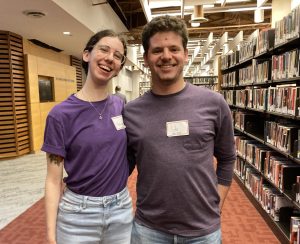If you want to understand Palestinian political consciousness, look no further than a cartoon character named Handala. Made of white card stock inked with black marker and held high above the crowd, Handala made his most recent appearance Jan. 15 at a West Bank rally calling for non-violence and an end to the occupation, hosted by two Israeli-Palestinian groups: Combatants for Peace and Standing Together.

Handala was created by the late Palestinian cartoonist Naji Al-Ali, who drew in the 1970s and 1980s. He’s depicted as a barefoot, 10-year-old Palestinian child whom Al-Ali describes as “not a fat, happy, relaxed or pampered child.” Handala is bald, save for several spikes of hair, and he clasps his hands “behind his back as a sign of rejection at a time when solutions are presented to us the American way.”
When Handala returns to Palestine, Al-Ali adds, he “will still be 10, and then he will start growing up… Things will become normal again when the homeland returns.” (Al-Ali’s words come from the website handala.org.)

Like other North American kids of my generation, I, too, grew up with a bald cartoon character created around the same time as Handala. Tom Wilson’s Ziggy faced daily challenges and existential dilemmas, but serious political commentary was absent. In my Ziggy-illustrated binder in sixth grade at Winnipeg’s Talmud Torah school, I learned about Zionist history, sang Hatikvah, and memorized the list of Israeli presidents and prime ministers for the annual JNF Israel contest. No notes were taken of the Palestinian experience.
Looking at Handala points to some uncomfortable truths. First, Palestinian resistance – and yes, even rejection of proposals they deem unjust – is a reality.
We could point to the Palestinian rejection of the 1947 UN partition resolution and conclude Palestinians made their bed that day and, therefore, must lie in it. Sure, how sweet it would have been had the Palestinian national movement agreed to the division. But it’s not surprising that a national group whose collective identity was tied up in the land opposed it. And now, in 2016, with Israel occupying the West Bank as a dangling appendage to its post-1949 armistice borders, we must acknowledge that a Palestinian state based on 1967 lines – if the parties ever agree on it – is still only 22 per cent of the land Palestinians view as theirs.
But the toughest part of Handala for Israelis and their supporters to stomach is the fact he’s not merely a West Bank resident opposing military occupation and desiring Palestinian national sovereignty. Handala represents the crux of historical Palestinian memory. He’s a refugee child, frozen in time, who hopes to return. When Zionists hear “refugee return,” they fear refugee flooding and the end of the Jewish state – what Israelis call the “demographic threat.”
READ: I WISH RABBIS WOULD DENOUNCE FAR-RIGHT ZIONISM
It’s well known in policy circles that there are clear and obvious solutions to the refugee question that address some – though not all – Palestinian claims. These might involved some family reunification and mostly repatriation to a new Palestinian state in the West Bank (and possibly Gaza). They may involve financial compensation. And, though it’s hard to imagine such words being uttered by Israel’s current government, there may even be some sort of apology, or at least recognition of some responsibility.
PA President Mahmoud Abbas has already publicly renounced his claim to territory in pre-1967 Israel. But collective memory is strong, and the injustice of the Nakba – whether primarily a function of Israeli expulsions or Arab states’ decision to launch war following Israel’s 1948 declaring of independence – still stings.
In order to inch toward agreement with the Palestinians, the hard work of government-to-government negotiation must be supplemented by the people-to-people work of setting the stage for ratifying any deal. Part of this means taking the historical narratives of the other seriously and realizing the gaping wounds of memory are difficult to suture without really listening and understanding.






